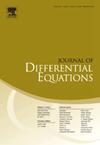双极源汇耦合二维Keller-Segel系统多峰聚集轴对称爆破解的存在性
IF 2.3
2区 数学
Q1 MATHEMATICS
引用次数: 0
摘要
我们考虑了Rd中的Keller-Segel系统,耦合了双极源和汇流。针对二维情况(d=2),我们建立了轴对称条件下解的有限时间爆破,而不要求解是径向的。特别地,我们证明了多个爆破点成对出现(即偶数),远离原点,位于x1轴上,并表现出关于x2轴的轴对称。这个结果适用于总质量严格大于16π的初始数据,并且与经典的径向设置形成对比,其中爆炸仅限于原点。我们分析的一个关键部分是一个尖锐的ε-正则定理,它最初是为经典的Keller-Segel系统开发的,并首先由Luckhaus-Sugiyama-Velázquez[12]建立。该定理表明,如果x1周围的局部质量在t1时刻足够小,则解在以(x1,t1)为中心的时空中保持在一个合适的抛物线圆柱体中。与经典的ε-正则性定理相比,它需要更弱的假设,得出的结论也更弱,这使得它成为一种局部正则性的形式,对于分析爆炸奇点特别重要。基于这个锐利的ε-正则性定理,我们进一步证明了只有有限个爆破点作为奇异集出现,并且渐近轮廓被表征为L1(R2)中有限个δ-函数和正则部分的和。此外,我们的研究结果表明,无论是否存在非琐碎流动,都可能发生多峰爆炸现象,这突出了扩散、趋化性和持续平流之间复杂的相互作用。通过考虑非衰减流并采用精确的爆破准则,我们建立了爆破时间可以被任何规定的阈值所限定。这些发现是通过建立一个强解的时间局部存在和扩展理论来证明的,该理论包含了平流和质量守恒。本文章由计算机程序翻译,如有差异,请以英文原文为准。
Existence of axis-symmetric blow-up solution with multiple peak aggregations for the 2-D Keller-Segel systems coupled bipolar source and sink flow
We consider the Keller-Segel systems in , coupled with a bipolar source and sink flow. Focusing on the two-dimensional case (), we establish finite-time blow-up of solutions under an axis-symmetric setting, without requiring the solutions to be radial. In particular, we prove that multiple blow-up points appear in pairs (i.e., in even numbers) away from the origin, lying on the -axis and exhibiting axis-symmetry about the -axis. This result holds for initial data with total mass strictly greater than 16π, and stands in contrast to the classical radial setting, where blow-up is confined to the origin.
A crucial part of our analysis is a sharp ε-regularity theorem, originally developed for the classical Keller-Segel systems and first established by Luckhaus–Sugiyama–Velázquez [12]. This theorem states that if the local mass around is sufficiently small at some time , then the solution remains locally bounded in a suitable parabolic cylinder in space–time centered at . Compared to the classical ε-regularity theorem, it requires weaker assumptions and yields weaker conclusions, making it a form of partial regularity that is particularly essential for analyzing blow-up singularities.
Based on this sharp ε-regularity theorem, we further prove that only finitely many blow-up points appear as singular sets, and the asymptotic profile is characterized as the sum of a finite number of δ-functions and a regular part in . Moreover, our results reveal that multi-peak blow-up phenomena can occur with or without the presence of non-trivial flow, highlighting the intricate interplay between diffusion, chemotaxis, and persistent advection. By accounting for non-decaying flow and employing precise blow-up criteria, we establish that the blow-up time can be bounded above by any prescribed threshold. These findings are justified through the construction of a time-local existence and extension theory for strong solutions, which incorporates both advection and mass conservation.
求助全文
通过发布文献求助,成功后即可免费获取论文全文。
去求助
来源期刊
CiteScore
4.40
自引率
8.30%
发文量
543
审稿时长
9 months
期刊介绍:
The Journal of Differential Equations is concerned with the theory and the application of differential equations. The articles published are addressed not only to mathematicians but also to those engineers, physicists, and other scientists for whom differential equations are valuable research tools.
Research Areas Include:
• Mathematical control theory
• Ordinary differential equations
• Partial differential equations
• Stochastic differential equations
• Topological dynamics
• Related topics

 求助内容:
求助内容: 应助结果提醒方式:
应助结果提醒方式:


